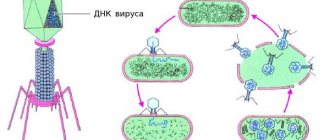November 30, 2021
One of the main reasons for the spread of rotaviruses is non-compliance with personal hygiene rules, when transmission of infection occurs through hands, which in turn contaminate dishes, toys, and linen
The pathogen is transmitted through dirty hands, that is, the transmission mechanism is fecal-oral, although airborne droplets are also possible. It can affect people at any age, and the causative agent of rotavirus gastroenteritis is a virus from the order Rotavirus, family Reoviridae. Routes of transmission: contact and household (through dirty hands and household items); aqueous (when drinking water infected with viruses, including bottled water); nutritional (most often when consuming milk and dairy products).
The possibility of airborne transmission of rotavirus infection cannot be ruled out. But one of the main reasons for the spread of rotaviruses is non-compliance with personal hygiene rules, when transmission of the infection occurs through hands, which in turn contaminate dishes, toys, and linen.
The carrier of the infection is a sick person or a healthy virus carrier. The virus multiplies in the cells of the mucous membrane of the gastrointestinal tract and is excreted in the feces for up to 3 weeks (usually 7-8 days from the first symptoms of the disease). Damage to the mucous membrane of the digestive tract disrupts the digestion of food and leads to the development of severe diarrhea and dehydration. The main mechanism of transmission of rotavirus infection is through food. Infection occurs through the fecal-oral route.
Symptoms of rotovirus
Rotavirus or intestinal flu is highly contagious and spreads quickly in confined spaces. If one family member becomes ill, then with a high degree of probability the infection will be transmitted to everyone. Most often, patients complain of dizziness, nausea, weakness, chills, vomiting and diarrhea.
One of the leading symptoms of rotavirus infection is sudden onset of diarrhea.
During the course of the disease, there is an incubation period lasting up to 5 days, an acute period lasting 3–7 days, and a recovery period (4–5 days).
The onset of the disease is always sudden and is characterized by a sharp increase in temperature, as well as repeated increasing vomiting, cramping pain and rumbling in the abdomen, and the development of diarrhea is possible. The nature of the stool helps diagnose rotavirus infection. On the first day of illness, the stool is liquid yellow in color; in subsequent days, the stool becomes gray-yellow with a clay-like consistency. In addition to intestinal manifestations of the disease, patients are bothered by a runny nose, sore and sore throat, and cough.
The frequency of bowel movements often corresponds to the severity of the disease. If you have large, loose stools, dehydration may develop. From the very beginning of the disease, abdominal pain may be observed. More often they are moderate, constant, localized in the upper half of the abdomen; in some cases - cramping, strong. Signs of damage to the digestive organs persist for 3–6 days.
Antibacterial therapy of infectious diarrhea in children
Infectious diarrhea currently ranks second in the structure of infectious morbidity in children, second only to acute respiratory infections. The incidence rate of acute intestinal infections (AEI) in children is 2.5–3 times higher than in adults, while more than half of the registered cases of infectious diarrhea occur in young children. According to the World Health Organization (WHO) (2008), up to 2 billion diarrheal diseases are registered annually in the world and about 5 million children die annually from intestinal infections and their complications. In Europe, between 0.5 and 1.9 episodes of infectious diarrhea are reported annually in every child under 3 years of age [1]. In children, infectious diarrhea remains a leading cause of death, not only in developing countries [2, 3].
Currently, in Russia there are no coordinated approaches to the treatment of acute intestinal infections in children, and the frequency of prescription of antimicrobial drugs remains at a high level, especially in hospitalized patients [4]. For this reason, it seems relevant to cover the issues of antimicrobial therapy of acute intestinal infections at the present stage. Before starting treatment for acute intestinal infections, it is necessary to establish the pathogenetic type of diarrhea (invasive, secretory, osmotic or mixed), determine the syndrome of damage to the gastrointestinal tract (GIT) (gastritis, gastroenteritis, enteritis, gastroenterocolitis, enterocolitis, colitis, distal colitis), in addition , it is necessary to diagnose developed complications of acute intestinal infections (dehydration syndrome, infectious-toxic shock, hemolytic-uremic syndrome, etc.) and assess the patient’s premorbid background (does the patient have food allergies, malabsorption syndrome, immunodeficiency state, etc.) [ 5].
The basic principles of therapy for acute intestinal infections in children involve a targeted effect, first of all, on the macroorganism, causing the correction of the resulting water and electrolyte disorders, as well as the elimination of the pathogen. For acute gastroenteritis, WHO considers the effectiveness of two therapeutic measures to be absolutely proven: rehydration and diet therapy (2006). It should not be forgotten that more than 70% of all infectious diarrhea in children are caused by viral agents [3, 6, 7], and for viral infections, antibacterial therapy is not only not indicated, but also causes significant harm to the macroorganism [8, 9].
The most controversial question remains about the advisability of using antimicrobial agents in the treatment of bacterial acute intestinal infections in children. When prescribing an antibiotic in these cases, the doctor expects: a decrease in the severity of clinical symptoms; reducing the duration of the disease; reducing the incidence of complications; cessation of excretion of the pathogen; preventing further spread of infection [10].
At the same time, it has been proven that the use of antibiotics for bacterial diarrhea is not always effective and safe. In enterohemorrhagic escherichiosis caused by both E. coli O157:H7 and E. coli O104:H4, the use of antibiotics leads to massive release of Shiga-like toxin, therefore increasing the risk of developing hemolytic uremic syndrome (HUS). At the same time, the inclusion of fluoroquinolones and trimethoprim/sulfamethoxazole in therapy was accompanied by a high risk of developing HUS, and the safest and most effective was the use of carbapenems, macrolides and rifaximin [11].
The prescription of antimicrobial drugs for bacterial diarrhea in a significant percentage of cases not only does not lead to the sanitation of the macroorganism from the pathogen, but, on the contrary, contributes to the long-term persistence of the bacterial agent in the gastrointestinal tract, due not only to the suppressive effect on the normal intestinal microflora, but also to the direct immunosuppressive effect [12 , 13]. According to domestic and foreign researchers, prolonged convalescent bacterial excretion of Salmonella is formed in a significant number of patients who received antibiotics in the acute phase of infection, compared to individuals who received exclusively pathogenetic therapy [14, 15]. According to our own data, bacterial excretion of Salmonella during the period of convalescence was noted on average in 37% of children treated with systemic antimicrobial agents. The effect of antimicrobial therapy on the immune response was shown by the authors in shigellosis, and combined antibacterial therapy led to a pronounced suppression of both the humoral immune response and phagocytosis parameters [16].
The most serious drawback of the widespread use of antibacterial drugs in the treatment of infectious diarrhea is the rapid development of antimicrobial resistance in members of the family Enterobacteriaceae [17]. Thus, domestic authors have recorded a steady increase in the number of Salmonella enteritidis strains that are resistant to most starting antimicrobial drugs. For example, up to 60% of circulating Salmonella strains are currently resistant to nalidixic acid [14]. Increasingly, Campylobacter strains are being identified that have broad antibiotic resistance, including to macrolides and fluoroquinolones [14, 18]. In parallel with the increase in antibiotic resistance, a decrease in the clinical effectiveness of initial antibiotic therapy when prescribing nalidixic acid was noted; it decreased by 2009 compared to 2000–2005. from 61% to 48.3%, and when using amikacin - from 53.9% to 31.7% [14, 15].
In addition, the use of antimicrobial drugs often causes the development of allergic reactions, including anaphylactic shock, and the prescription of antibiotics can lead to the development of not only idiopathic antibiotic-associated diarrhea, but also severe antibiotic-associated colitis caused by toxin-forming strains of Clostridium difficile [6, 10].
A few pharmacoepidemiological studies conducted in Russia have shown that in children suffering from ACI, in most cases, antibiotic therapy is used in the hospital (72–100% of hospitalized patients), and at least a third of patients do not have any indications for its use, while in many hospitals ineffective or toxic drugs are used (chloramphenicol, natural penicillins, rifampicin) [4, 19, 20].
In practical healthcare, not only are there errors in choosing an antimicrobial drug for the treatment of infectious diarrhea, but also often there are both insufficient and excessive doses of prescribed drugs, an inadequate route of administration, incorrect choice of intervals between administrations, and an unreasonable combination of two or more antibacterial agents [13] . If the dose of an antibiotic is insufficient and does not provide concentrations in the blood and tissues that exceed the minimum inhibitory concentrations of the main infectious agents, then this not only becomes one of the reasons for the ineffectiveness of treatment, but also creates the preconditions for the formation of antibiotic resistance in microorganisms. In the current situation, with the availability of highly effective broad-spectrum antimicrobial drugs for the treatment of ACI, there are practically no indications for combination antibacterial therapy and the priority in treatment remains with monotherapy [6, 18, 21].
In addition, until now, for infectious diarrhea, unreasonably long-term antibacterial therapy is carried out with a change of 3-4 drugs; less often, unreasonably short antimicrobial therapy takes place [4].
Due to the above, currently the indications for the use of antibiotics in the treatment of AEI are strictly limited and are determined by the type of diarrhea and the etiology of the disease, the severity of the infectious disease, the age and premorbid background of the patient [6, 9, 21].
An antimicrobial drug intended for the treatment of infectious diarrhea in children must meet the following criteria: have high activity against the main circulating pathogens of bacterial acute infections; have a bactericidal effect; have high bioavailability of the active substance and create a high concentration in the gastrointestinal tract. It is necessary that the level of strains that are resistant to the drug be low. An important role in pediatrics is played by the safety profile (the number and nature of toxic effects), pharmacoeconomic characteristics (the ratio of effectiveness, safety and cost) of the drug, a child-friendly dosage form (suspension) and dosage regimen of the drug [1, 5–7].
Yu. B. Belousov and S. M. Shatunov (2001) proposed dividing antimicrobial drugs for the treatment of intestinal infections into two groups. The first is drugs that are not absorbed after oral administration (i.e., have low bioavailability) and provide an antimicrobial effect only in the intestine, without having a systemic effect (the so-called intestinal antiseptics - nitrofurans, non-fluorinated quinolones and quinolines, some sulfonamides, etc.) ; the second is antibiotics that are well absorbed in the small intestine, which have a systemic effect, but at the same time provide low therapeutic concentrations in the intestinal wall (fluoroquinolones, chloramphenicol, tetracyclines, macrolides, nitroimidazoles, etc.) [22].
High concentrations of drugs of the first group in the digestive tract are an important characteristic for the treatment of infectious diarrhea, but in the case of generalized infection, these antimicrobial agents are ineffective, since they do not provide therapeutic concentrations in the blood and parenchymal organs [22–24]. In recent years, non-absorbable antimicrobial drugs have been widely used in the treatment of bacterial acute intestinal infections. Their advantages over systemic antibiotics are: the possibility of direct action on the bacterial agent with a low risk of developing strain resistance; almost complete absence of negative impact on normal microflora; low incidence of systemic adverse reactions; absence of drug interactions, since they do not affect the enzymes of the cytochrome P450 system [25–28].
In accordance with WHO recommendations, antimicrobial therapy for infectious diarrhea is indicated only for the following nosological forms: cholera, typhoid fever, shigellosis and amebiasis [1].
According to leading domestic infectious disease specialists, indications for prescribing antimicrobial therapy in children with acute intestinal infections are the development (threat of development) of generalized forms (typhoid-like, septic) diseases; severe forms of invasive diarrhea, as well as moderate forms of invasive acute intestinal infections in children at risk. Risk group patients include children with severe chronic diseases (primary immunodeficiencies, malignant neoplasms, inflammatory bowel diseases, surgically corrected congenital heart defects, juvenile arthritis, etc.) and young children (the first 6–12 months of life) [6 , 7, 21]. In addition to the above persons, antibacterial therapy is mandatory for patients with yersiniosis.
The principles of rational antibacterial therapy for acute intestinal infections in children include timely administration of the drug (the period at the height of the disease); division of used antimicrobial drugs into starting, alternative and reserve drugs; taking into account the antibiotic sensitivity of isolated strains; using the optimal method, dose, frequency of administration and course of therapy, as well as taking into account the individual characteristics of the patient (age, premorbid background, etc.).
Most foreign sources consider ceftriaxone and azithromycin to be the drugs of choice for the treatment of infectious diarrhea in children with clinical hemocolitis, and fluoroquinolones and azithromycin in adult patients [1, 18]. The duration of prescription of antimicrobial drugs does not exceed 5 days, and in many cases is limited to 24–48 hours. Ampicillin, nalidixic acid, trimethoprim/sulfamethoxazole, and nitrofurans remain relevant for the treatment of shigellosis [18, 29].
It is advisable to use starting drugs for antibacterial therapy of acute intestinal infections in the early stages of the disease in moderate forms of invasive diarrhea and in the absence of individual drug intolerance. Preference is given to drugs with a broad spectrum of action, which have a bactericidal or bacteriostatic effect, are poorly absorbed from the intestine and do not have an overwhelming effect on the autochthonous microflora. Such drugs include hydroxyquinoline derivatives, nitrofurans, and aminoglycosides of the 1st and 2nd generation. Since the choice of antibacterial drug in the acute period of infectious diarrhea is carried out empirically, if necessary, therapy should be adjusted in accordance with the antibiotic sensitivity of the isolated pathogen [13, 22].
The effectiveness of antibacterial therapy, the main criteria of which are normalization of body temperature, relief or reduction of the severity of intoxication and diarrhea syndrome, is assessed within 48–72 hours after the start of treatment. In the absence of positive clinical dynamics or progression of disease symptoms, as well as in the later stages of the disease, other antibiotics can be used as an alternative to starting antibiotics: protected aminopenicillins, non-fluorinated quinolones (nalidixic acid), chloramphenicol, II generation macrolides, II-III generation cephalosporins, II-III aminoglycosides III generation (amikacin, netilmicin), nitroimidazoles. In severe forms of acute intestinal infections, it is advisable to begin therapy with parenteral administration of antimicrobial drugs, and upon achieving a clinical effect, it is possible to switch to oral antibiotics until the full course of therapy is completed.
Reserve antibiotics are used exclusively in hospital settings, have a wide spectrum of action and are highly effective against almost all pathogens of acute intestinal infections, including those resistant to antibacterial drugs of initial and alternative therapy. Indications for the use of such drugs are generalized and septic forms of acute intestinal infections, severe acute intestinal infections in children with an unfavorable premorbid background, suspicion of the nosocomial nature of the disease, as well as the ineffectiveness of the above groups of antibiotics. Reserve drugs include III-IV generation cephalosporins, carbapenems, II-III generation aminoglycosides, fluoroquinolones (can be used in children only for health reasons) [8, 21, 22].
When choosing etiotropic therapy, it is necessary to take into account not only the suspected causative agent of acute intestinal infections, but also the rapidly developing resistance of circulating enterobacteria to traditionally used antibacterial agents. In this regard, recommendations for choosing the optimal antibacterial agent must necessarily be based on regional data on the structure of antibiotic resistance.
In pediatric practice, there are difficulties in antimicrobial therapy of infectious diarrhea, especially with regard to oral forms of drugs and is primarily due to age restrictions on the use of drugs in pediatrics. Thus, nalidixic acid is approved for use from 2 years of age (and according to some sources from 18 years of age); rifaximin from the age of 12, and Intetrix is currently not approved at all in pediatrics.
Consequently, the main starting drug in pediatric infectology in recent years is nifuroxazide. Nifuroxazide belongs to nitrofuran drugs, the antibacterial activity of which is due to the production of nitroanions. Nitrofuran preparations are acceptors of hydrogen ions during the transfer of electrons from flavin enzymes to cytochrome, thereby blocking energy formation in the bacterial cell. In addition, nifuroxazide blocks the activity of aldolases, dehydrogenases, transketolases and the synthesis of macroprotein complexes. As a result of these interactions of nitrofurans with bacterial agents, the processes of growth and division of bacterial cells are disrupted. It has been proven that nifuroxazide in moderate therapeutic doses has a bacteriostatic effect, and in high doses it has a bactericidal effect [23, 24, 30].
Gram-negative representatives of various families Enterobacteriaceae, Vibrionaceae, Campylobacteriaceae (Escherichia coli, Shigella spp., Salmonella spp., Proteus spp., Klebsiella spp., Aerobacter faecalis, Aerobacter aerogenes, Vibrio cholerae, Campylobacter spp., Haemophillus spp.) are sensitive to the action of nifuroxazide. ; gram-positive cocci (Staphylococcus spp., Streptococcus spp., Corynebacterium spp.); pathogenic and opportunistic fungi (Candida albicans, Microsporum spp., Trichophyton spp.); some protozoa (Trichomonas vaginalis, Lamblia intestinalis, Entamaeba hystolytica).
Nifuroxazide is a local antiseptic and is practically not absorbed into the blood from the gastrointestinal tract, does not affect the endogenous microflora, and practically does not lead to the formation of antibiotic-resistant strains [30, 31].
In Russia and abroad there is extensive positive experience in the use of nifuroxazide for shigellosis, salmonellosis, and acute intestinal infections caused by opportunistic pathogens [15, 31, 32]. In 2013, nifuroxazide was registered in the Russian Federation under the trade name Stopdiar, and this drug has two dosage forms - 100 mg film-coated tablets, approved from 6 years of age, and a suspension form for patients from 2 months of age. This dosage form is complex, since in addition to nifuroxazide (5 ml = 220 mg), it contains simethicone. Simethicone is a surface-active defoaming agent that reduces gas formation in the intestines. The content of simethicone in the Stopdiar suspension is especially important for young children who suffer from increased gas formation due to infectious diarrhea.
Thus, the growth and change in the drug sensitivity of strains of pathogens of invasive diarrhea requires strict approaches to the prescription of antimicrobial drugs for acute intestinal infections in children; it is advisable to use a stepwise therapy regimen, which is determined by high clinical effectiveness and a decrease in the psychotraumatic effect on the small patient. Considering the wide spectrum of antibacterial action, the almost complete absence of influence on normal microflora, the high safety profile and the presence of a suspension dosage form, the intestinal antiseptic nifuroxazide can be considered a starting drug in the treatment of infectious diarrhea in children.
Literature
- Guarino A., Albano F., Ashkenazi S., Gendrel D., Hoekstra JH, Shamir R., Szajewska H. European Society for Pediatric Gastroenterology, Hepatology and Nutrition/European Society for Pediatric Infectious Diseases Evidence-based Guidelines for the Management of Acute Gastroenteritis in Children in Europe // J Pediat Gastroenterol Nutr. 2008. Vol. 46, Suppl. 2, 81–122.
- Casburn-Jones AC, Farthing MJG Management of infectious diarrhoea // Gut. 2004; 53(2):296–305.
- Hatchette TF, Farina D. Infectious diarrhea: when to test and when to treat // CMAJ. 2011; 183:339–344.
- Grekova A.I., Zharkova L.P. Choice of antibacterial therapy for acute intestinal infections in children (results of a multicenter analytical study) // Pediatric pharmacology. 2007. T. 4, no. 3. pp. 16–19.
- Gorelov A.V., Milyutina L.N., Usenko D.V. Clinical guidelines for the diagnosis and treatment of acute intestinal infections in children. A manual for doctors. M., 2006. 109 p.
- Geppe N. A., Gorelov A. V., Dronov I. A. Problems of antibacterial therapy for intestinal infections in children // Medical Council. 2011. No. 5. pp. 22–26.
- Mazankova L. N., Ilyina N. O. Modern aspects of diagnosis and treatment of acute intestinal infections in children. Russian Bulletin of Perinatology and Pediatrics. 2007. No. 2. P. 4–10.
- Lobzin Yu. V., Zakharenko S. M. Etiotropic therapy of intestinal infections // Infectious diseases. 2009. T. 7. No. 3. P. 62–67.
- Lobzin Yu. V. Diarrhea, modern approaches to treatment (foreign review) // Clinical microbiology and antimicrobial chemotherapy. 2001. No. 3. P. 76–84.
- American Academy of Pediatrics. In: Pickering LK ed. Red Book: 2003 Report of the Committee on Infectious Diseases. 26 th ed. Elk Grove Village, IL: American Academy of Pediatrics.
- Bielaszewska M., Idelevich E.A., Zhang W., Bauwens A., Schaumburg F. et al. Effects of antibiotics on Shiga toxin 2 production and bacteriophage induction by epidemic Escherichia coli O104: H4 strain // Antimicrob Agents Chemother. 2012. Vol. 56(6). R. 3277–3282.
- Tets V.V. Microorganisms and antibiotics. Sepsis. St. Petersburg: Aesculapius, 2003. 153 p.
- Zakharenko S. M. Therapy of intestinal infections in Russia: Rational or empirical? // Journal of Infectology. 2011. T. 3. No. 2. pp. 81–96.
- Milyutina L.N., Guryeva O.V., Golubev A.O., Rozhnova S.Sh., Ulukhanova L.U. Current problems and trends in the evolution of modern salmonellosis in children // Epidemiology and infectious diseases. 2011. No. 1, p. 43–48.
- Ploskireva A. A., Gorelov A. V., Usenko D. V., Bondareva A. V., Tkhakushinova N. Kh., Ulukhanova L. U. Efficiency of etiotropic therapy of bacterial acute intestinal infections in children at the present stage // Infectious diseases. 2011. T. 9. No. 4. pp. 79–83.
- Tikhomirova O.V., Bekhtereva M.K., Khusein J., Kvetnaya A.S. et al. Features of the course of Flexner’s dysentery and rational etiotropic therapy in children at the present stage // Ros. Bulletin of Perinatology and Pediatrics. 2002. No. 6. p. 46–52.
- Selected issues in the therapy of infectious patients / Ed. Lobzina Yu. V. St. Petersburg: Folio. 2005. 987 p.
- Tazalova E. V. Sensitivity of campylobacteria to antibiotics and some mechanisms of the formation of antibiotic resistance // Far Eastern Medical Journal. 2012. No. 3. pp. 120–123.
- Diniz-Santos Daniel R., Silva Luciana R., Silva Nanci. Antibiotics for the Empirical Treatment of Acute Infectious Diarrhea in Children // The Brazilian Journal of Infectious Diseases. 2006; 10 (3): 217–227.
- Gorbacheva E.V. Pharmacoepidemiological analysis of the use of antimicrobial drugs in children with acute intestinal infections in the Far Eastern region // Bulletin of Volg State Medical University. 2011. Issue. 3 (39). pp. 109–112.
- Acute intestinal infections in children. Educational manual / Ed. Uchaikina V. F. M.: State Educational Institution of Higher Professional Education RGMU. 2005. 116 p.
- Belousov Yu. B., Shatunov S. M. Antibacterial chemotherapy. M.: Remedium, 2001. 473 p.
- Bouree P., Chaput JC, Krainik F., Michel H., Trepo C. Double-blind controlled study of the efficacy of nifuroxazide versus placebo in the treatment of acute diarrhea in adults // Gastroenterol Clin Biol. 1989, May; 13 (5): 469–472.
- Buisson Y., Larribaud J. Effects of nifuroxazide on fecal flora in healthy subjects // Therapie. 1989, Mar-Apr; 44 (2): 123–126.
- DuPont HL Community-acquired diarrheal disease in western countries: applications of nonabsorbable oral antibiotic therapy // Adv Stud Med. 2003; 3 (suppl A): S945–S950.
- DuPont HL Travelers' diarrhoea: Contemporary approaches to therapy and prevention // Drugs. 2006; 66:303–314.
- Taylor D., Bourgeois AL, Ericsson Ch. D. A randomized, double-blind, multicenter study of rifaximin compared with placebo and with ciprofloxacin in the treatment of travelers' diarrhea // Am. J. Trop. Med. Hyg. 2006. Vol. 74. P. 1060–1066.
- Scarpignato C., Pelosini I. Rifaximin, a poorly absorbed antibiotic: pharmacology and clinical potential // Chemotherapy. 2005. Vol. 51 (suppl. 1). P. 36–66.
- DuPont AW, DuPont HL Travelers' diarrhea: Modern concepts and new developments // Curr Treat Options Gastroenterol 2005; 9:13–21.
- Tavares LC, Chiste JJ, Santos MG, Penna TC Synthesis and biological activity of nifuroxazide and analogs // II. Boll Chim Farm. 1999, Sep; 138(8):432–436.
- Gorelov A.V., Usenko D.V., Kadzhieva E.P., Ardatskaya M.D. Evaluation of the clinical effectiveness of enterofuril in the complex therapy of acute intestinal infections in children and its effect on intestinal microbiocenosis // Infectious diseases. 2006. T. 4. pp. 79–83.
- Kadzhieva E. N., Usenko D. V., Gorelov A. V., Ardatskaya M. D. Modern nitrofurans in the treatment of intestinal infections in children // Farmateka. 2007. No. 13. pp. 79–82.
M. K. Bekhtereva1, Candidate of Medical Sciences O. A. Volokhova A. V. Vakhnina
FSBI NIIDI FMBA of Russia, St. Petersburg
1 Contact information
Prevention of rotavirus
Nonspecific prevention includes a set of sanitary and hygienic measures (regular hand washing, using only boiled drinking water, room ventilation, wet cleaning). Another important point is the timely isolation of a sick person who exhibits signs of acute respiratory viral infection and intestinal infection.
Gastroenterologists advise taking prebiotics and probiotics as a preventive measure. Probiotics, called “friendly bacteria,” are live microorganisms that aid digestion and improve protection against possible infections. Natural probiotics are found in fermented milk products: organic yogurt and cheeses, miso soup, sourdough bread, and sauerkraut. There are also probiotic supplements that come in capsules or drinks.
Indications for antibiotics
A fairly common mistake is the use of antibiotics for diseases that develop as a result of a non-bacterial infection.
Antibiotics should not be used for viral infections.
Among these diseases:
- Acute pharyngitis.
- Acute laryngotracheitis.
- Rhinitis.
- SARS, only.
- Acute bronchitis. It is permissible to use antibiotics when bronchial constriction develops, as well as when fever lasts more than 5 days.
In these cases, the prescription of antibiotics is not justified, since the cause that led to these diseases is often viruses.
There are also controversial points when both viruses and bacteria can lead to the development of the disease. Such diseases include:
- Acute rhinosinusitis.
- Acute otitis media.
- Acute tonsillitis.
In such cases, an antibiotic is prescribed only after examination and observation by a doctor of the patient.
For viral infections (pharyngitis, rhinitis, laryngitis, tracheitis), the effectiveness of antibiotics is equal to the placebo effect. It is important to remember that the prescription of antibacterial agents does not prevent the development of bacterial superinfection (that is, the addition of a bacterial infection to an existing viral one). There are no effective remedies against ARVI. The use of antiviral immunostimulating agents common in pharmacy chains often does not have any effect. In this case, the antiviral agent can be considered as ascorbic acid or garlic. In such cases, adequate pathogenetic and symptomatic treatment is prescribed, which allows eliminating and eliminating the symptoms of ARVI. Used: paracetamol, ibuprofen, mucolytics (ambroxol, acetylcysteine, carbocysteine), vasoconstrictor nasal drops for a runny nose, nasal corticosteroid for rhinosinusitis. If there is a disease with a viral or bacterial cause (tonsillitis, sinusitis, otitis media), then in this case antibacterial therapy delayed by 2-3 days is recommended. Delayed antibiotic prescribing for upper respiratory tract infections has reduced the frequency of antibiotic prescriptions by 40%.
These statements are of an evidentiary nature and are described in more detail in the training manual “ Rational use of antimicrobial agents in the outpatient practice of doctors , written on the basis and evidence base of the 2021 Eurasian recommendations.









